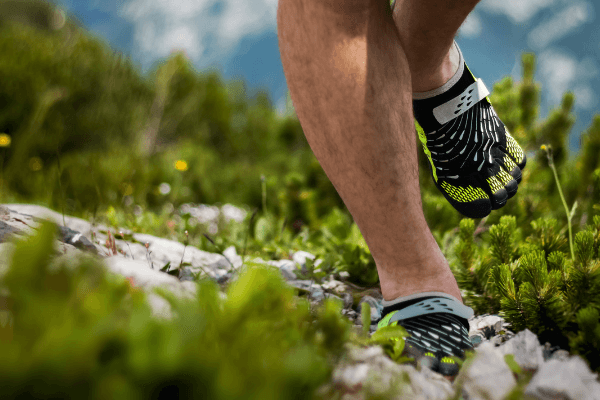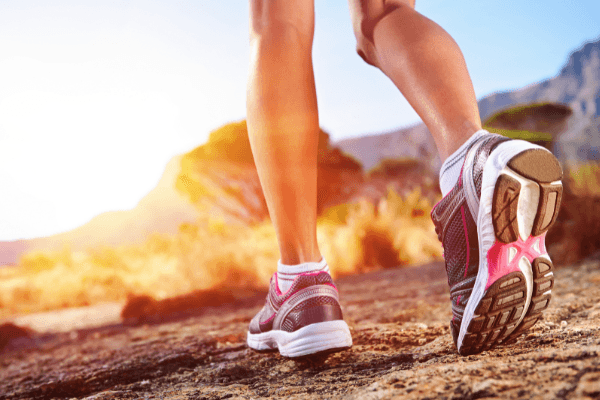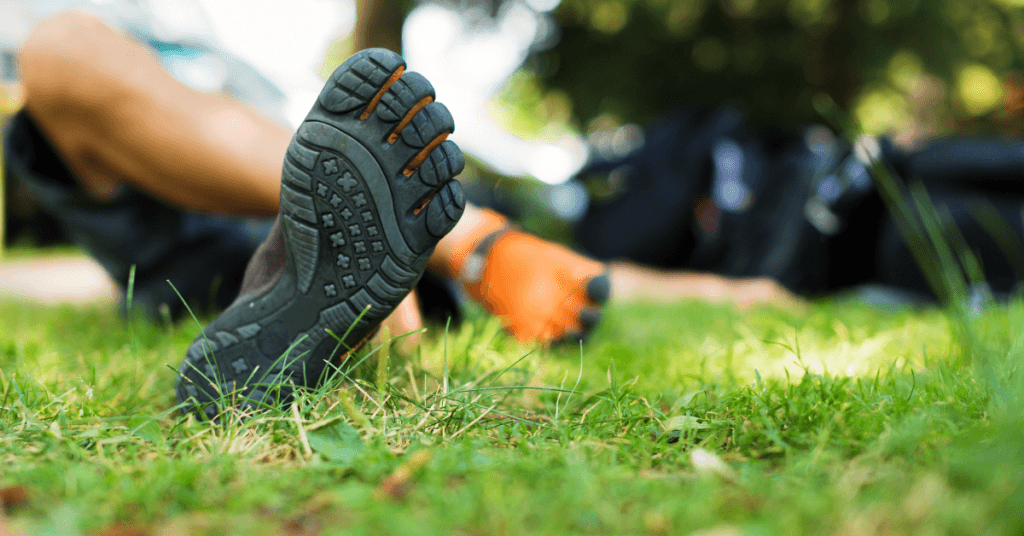What are barefoot running shoes, and should you buy a pair? They can provide better traction, foot protection, and comfort, but there are some disadvantages.
The first time I heard about barefoot running shoes, I thought, ouch, really? Barefoot running shoes are thin shoes that claim to improve running performance. Since my initial reaction, I’ve done a 180, experiencing firsthand how barefoot shoes improve my runs when I use them in the right setting.
Contents
What Are Barefoot Running Shoes and How Do They Work?
Barefoot running shoes look closer to gloves than shoes because they fit the contours of all five toes individually. They also have a zero drop, whereas middle-of-the-road minimalist shoes average an eight-millimeter drop.
Since barefoot shoes don’t have the heel-to-toe drop like running shoes, they force you to land on your midfoot instead of your heel.
That said, landing on your heel isn’t inherently wrong. However, many runners believe it creates a higher impact than necessary on the body.
Since there’s such little cushion between the sole of your foot and the ground, barefoot shoes encourage all foot muscles to work as they adapt to uneven terrain.
If you’re thinking, “but I don’t run on uneven terrain,” I get where you’re coming from. But unless you’re running on something as consistent as a treadmill, chances are there’s some unevenness; even small pebbles will force your foot muscles to work harder to stabilize.
Advantages of Barefoot Running Shoes

Now that you know the answer to “What are barefoot running shoes?” let’s explore their positive traits.
Although scientists need to run more studies to help support barefoot running shoe claims, many runners (including myself) will tell you that they notice an improvement. It doesn’t come without a learning curve, though.
So, some benefits you may experience when using barefoot running shoes include:
- Improved stride
- Better feel and reaction to terrain
- lighter weight
Weight can make a massive difference for racers and casual joggers alike. Using a shoe that doesn’t weigh as much puts your leg muscles under less strain, potentially helping you run faster and for a longer distance.
You might also find our neutral running shoes explainer useful.
Disadvantages of Barefoot Running Shoes
Barefoot running shoes strip the comforts of traditional shoes. While that might be welcome for some people, these shoes tend to put greater strain on the Achilles tendon than conventional running shoes.
For this reason, people with the following conditions are likely better off avoiding barefoot shoes during their run:
- Tendinitis
- Bunions
- Hammer toe
- Plantar fasciitis
Furthermore, running with barefoot shoes could increase the risk of injury if you have exceptionally flat feet.
Situations When You Shouldn’t Use a Barefoot Shoe

You now know how to answer someone when they ask you, “What are barefoot running shoes?” But are barefoot shoes good to use in all situations?
Definitely not.
Aside from the medical conditions above, below are some other scenarios when you should stick with your traditional running shoes instead of barefoot shoes.
- Snow
- Ice
- Rocky terrain
- Areas with broken glass
The bottom line is to use common sense. The more traction a running shoe has, the more it’ll help you remain stable when traversing challenging areas.
Furthermore, since barefoot shoes help you feel the ground beneath you, the tradeoff is that you could have a run-in with uncomfortable sharp pebbles and debris. Barefoot shoes aren’t for off-trail running, folks!
It’s also best to run in barefoot shoes only during the day or when there’s enough lighting at night to see where you’re stepping.
If you think you may be better suited to off-road terrain, check out our beginner’s guide to trail running.
The Science Behind Barefoot Running
To understand why barefoot running shoes are trending in the running world, I’ll give you a foundation of the science that has made runners go crazy over them.
Barefoot running caught more mainstream attention after Christopher McDougall published his book Born to Run: A Hidden Tribe, Superathletes, and the Greatest Race the World Has Never Seen.
The premise is that during McDougall’s time in the Copper Canyons of Mexico, he spent time with the Tarahumara indigenous people, who ran hundreds of miles with essentially no footwear or injuries.
So, what do scientists say about this? A lot, actually.
Since traditional running shoes have thick soles, padded heels, and arch support, they appear to make the foot weaker over time. In contrast, running in barefoot shoes forces your foot’s arch muscles to work harder as they navigate the dips, turns, and instability of the terrain where you run.
Of course, other studies question these claims as with any good scientific study. For example, one study found that running barefoot had a “limited to moderate” impact on running performance.
As a result, the researchers didn’t conclude one way or the other whether barefoot running had benefits or risks. Instead, they said they need more high-quality evidence through further research.
If you would like to start barefoot running, follow the link and have a look at our guide to get you started. You might also be interested in our explainer on why are running shoes so ugly.



